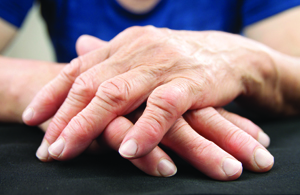What is psoriatic arthritis?
5/15/2025 by Andrea Pauly, APRN, C.N.P., and Kara Delger, APRN, C.N.P.

Psoriatic arthritis is when someone with a personal or family history of psoriasis develops inflammatory arthritis. This chronic condition is something they will have for life, and it’s more common in adults but can also be present in children. Psoriatic arthritis is not preventable, but there are risk factors (tobacco use and obesity) that people can work on to reduce the risk of developing this disease. Once diagnosed, some medications can help control the symptoms.
What is psoriasis?
Psoriasis is a skin condition that results from an overactive immune system. Psoriatic skin rashes can affect many areas of the body. Rashes typically involve skin redness in the affected area and scales or plaques of skin overlying the impacted skin. Fingernails and toenails can be impacted as well. Changes to the nails include pitting or indentation of the affected nails.
What is inflammatory arthritis?
Inflammatory arthritis refers to arthritis joint pain that is caused by an inflammatory process driven by an overactive immune system. This results in pain, swelling and stiffness of the joints and surrounding tissues. In psoriatic arthritis, unique patterns of joint disease can help a rheumatologist distinguish this diagnosis from other causes of joint pain. Common joints involved include small joints of the hands and feet, larger joints (knees, elbows and shoulders), and even spine joints. Tendons that connect muscles to bones can also become inflamed, which can be perceived as joint or muscle pain. Psoriatic arthritis affects up to 30% of patients who have psoriasis.
Can other organs be involved in psoriatic arthritis?
Other organs involved in this disease include ocular inflammation, like uveitis, and gastrointestinal inflammation, like Crohn's disease or ulcerative colitis.
What else can cause joint pain in someone who has psoriasis?
Osteoarthritis, or degenerative arthritis, is a common form of arthritis associated with aging and can lead to joint pain, which can sometimes be mistaken for psoriatic arthritis. Gout is another diagnosis that can cause joint pain and swelling and can be mistaken for psoriatic arthritis.
How is psoriatic arthritis diagnosed?
Psoriatic arthritis is diagnosed based on the presence or history of psoriasis and evidence of inflammatory arthritis with features and patterns consistent with the diagnosis of psoriatic arthritis. Blood testing, X-ray imaging, ultrasound and other more advanced imaging tests can and may be used to achieve the diagnosis.
How is psoriatic arthritis treated?
There is no cure for psoriatic arthritis. Permanent joint damage can result without treatment. Current treatment options provide many patients with success in easing symptoms and achieving remission. These therapies are targeted at reducing inflammation. Many of these options are also very effective in managing psoriasis skin lesions.
Therapy options may include:
- NSAIDs (Nonsteroidal anti-inflammatory drugs): These medications help to reduce inflammation and therefore help with pain. Examples include ibuprofen and naproxen. There are also prescription-strength options.
- Biologics agents: These are a newer class of disease-modifying agents. A few oral options are available, but more common options are available as a self-injection or infusion. They are generally tolerated well, target suppression of the overactive immune system and are associated with a high infection risk. Some do require laboratory monitoring.
- Conventional DMARDs (Disease-modifying antirheumatic drugs): These therapies are used less commonly but do have a role for use in some patients.
- Non-pharmacological options: Maintaining a healthy weight can reduce overall inflammatory burden and help control both joint and skin symptoms of psoriatic arthritis long term. Physical and occupational therapy may help manage isolated symptoms or lessen risk. Also, ice and heat could be helpful in isolated scenarios.
Takeaway
If you suspect you may have psoriatic arthritis, it's important to discuss this concern with your healthcare clinician. You may require a dermatologist and a rheumatologist to help manage this condition.
A growing number of therapies available to treat this condition allow many patients to have low or no disease symptoms.
Psoriatic arthritis is a chronic disease, and medications prescribed to help manage this condition should be taken as prescribed.
Andrea Pauly, APRN, C.N.P., is a nurse practitioner in the Department of Rheumatology at Mayo Clinic in Rochester, Minnesota, supporting the community and established patients. She has special interests in systemic autoimmune rheumatic disease and nurse practitioner medical education and training. She serves as a volunteer with the American College of Rheumatology.
Kara Delger, APRN, C.N.P., is a nurse practitioner in the Department of Rheumatology at Mayo Clinic in Rochester, Minnesota. She has a special interest and experience with inflammatory arthritides. She also supports patient education and medical education of nurse practitioners in rheumatology.
